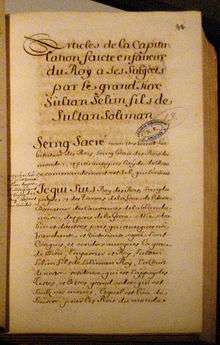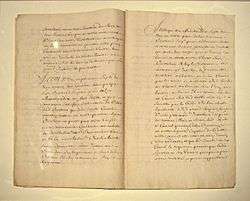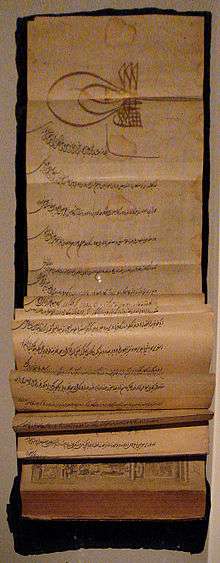Capitulations of the Ottoman Empire




Capitulations of the Ottoman Empire were contracts between the Ottoman Empire and European powers, particularly France. Turkish capitulations, or ahdnames, were generally bilateral acts whereby definite arrangements were entered into by each contracting party towards the other, not mere concessions.[1]
The Turkish Capitulations were grants made by successive Sultans to Christian nations, conferring rights and privileges in favour of their subjects resident or trading in the Ottoman dominions, following the policy towards European states of the Byzantine Empire.
According to these capitulations traders entering the Ottoman Empire were exempt from local prosecution, local taxation, local conscription, and the searching of their domicile.
The capitulations were initially made during the Ottoman Empire's military dominance, to entice and encourage commercial exchange with Western merchants. They were however increasingly exploited after military dominance shifted to Europe, allowing significant economic and political abuse by European powers. [2]
History
In the first instance capitulations were granted separately to each Christian state, beginning with the Genoese in 1453, which entered into peaceful relations with the Ottoman Empire. Afterwards new capitulations were obtained which summed up in one document earlier concessions, and added to them in general terms whatever had been conceded to one or more other states; a stipulation which became a most favored nation article.
Around 1535 a capitulation was made by Suleiman the Magnificent regarding France.
France signed its first treaty of Capitulations with the Mamluk Sultanate in Cairo in 1500, during the rule of Louis XII.[3][4] After the Turks conquered Egypt in the Ottoman–Mamluk War (1516–1517), the Ottomans upheld the capitulations to the French and applied them to the entire empire.
Status
Capitulations signified that which was arranged under distinct headings; the Ottoman Turkish phrase was ahid nameh, whereas a "treaty" was mouahed. The latter did, and the former did not, signify a reciprocal engagement.
According to Capitulations, and treaties confirmatory of them, made between the Porte and other states, foreigners resident in Turkey were subject to the laws of their respective countries.
Thus, although the Turkish capitulations were not in themselves treaties, yet by subsequent confirmation they acquired the force of commercial durable instead of personal nature; the conversion of permissive into perfect rights; questions as to contraband and neutral trade stated in definite terms.
Abolition
In 1914, the Committee of Union and Progress abolished the capitulations in the Ottoman Empire and introduced economic policies that would benefit the Ottoman economy.
As far as Turkey is concerned, the capitulations were abolished by the Treaty of Lausanne (1923), specifically by Article 28:
Each of the High Contracting Parties hereby accepts, in so far as it is concerned, the complete abolition of the Capitulations in Turkey in every respect.[5]
Capitulations in Egypt ended in 1949 as stipulated in the Montreux Convention Regarding the Abolition of the Capitulations in Egypt in 1937.[6]
List of capitulations
Capitulatory treaties were signed with the following countries:[7][8]
- Venice (1454)
- France (1535, 1673, 1740)
- England (1579, 1675, 1809)
- Netherlands (1579, 1680)
- Austria (1615)
- Russia (1711, 1783)
- Sweden (1737)
- Sardinia (1740, 1825)
- Denmark (1746 or 1756)
- Prussia (1761)
- Spain (1782)
- United States (1830)
- Belgium (1838)
- Hanseatic League (1839)
- Portugal (1843)
- Greece (1854 or 1855)
- Brazil (1858)
- Bavaria (1870)
See also
- Foreign relations of the Ottoman Empire
- French post offices in the Ottoman Empire
- French post offices in Crete
- Chester concession
- Ottoman Public Debt
- Ottoman Public Debt Administration
- Mixed Courts of Egypt
- Ahidnâme
References
- ↑ As regards technical distinctions, an agreement, an exchange of notes, or a convention properly applies to one specific subject; whereas a treaty usually comprises several matters, whether commercial or political.
- ↑ Cleveland, William; Bunton, Martin (2009). A History of the Modern Middle East (4 ed.). Westview Press. p. 50. ISBN 978-0-8133-4374-7.
- ↑ Three years in Constantinople by Charles White p.139
- ↑ Three years in Constantinople by Charles White p.147
- ↑ In addition to Turkey, the British Empire, France, Italy, Japan, Greece, Romania and the Kingdom of Yugoslavia were parties to the Treaty.
- ↑ Convention regarding the Abolition of the Capitulations in Egypt, Protocol, and Declaration by the Royal Egyptian Government (Montreux, 8 May 1936) Art 1.
- ↑ Lucius Ellsworth Thayer, "The Capitulations of the Ottoman Empire and the Question of their Abrogation as it Affects the United States", The American Journal of International Law, 17, 2 (1923): 207–33.
- ↑ Philip Marshall Brown, Foreigners in Turkey: Their Juridical Status (Princeton University Press, 1914), p. 41.
 This article incorporates text from a publication now in the public domain: Chisholm, Hugh, ed. (1911). "Capitulations". Encyclopædia Britannica (11th ed.). Cambridge University Press.
This article incorporates text from a publication now in the public domain: Chisholm, Hugh, ed. (1911). "Capitulations". Encyclopædia Britannica (11th ed.). Cambridge University Press.
Bibliography
- Hoyle, Mark S. W. (1991). Mixed courts of Egypt. London: Graham & Trotman. xxvii, 206p.
- F. Ahmad, "Ottoman perceptions of the capitulations 1800-1914," Journal of Islamic Studies, 11,1 (2000), 1-20.
- Maurits H. van den Boogert and Kate Fleet (eds.), ed. (2003). The Ottoman capitulations: text and context. Rome: Istituto per l'Oriente C.A. Nallino. pp. vii, [575]-727, 14p. of plates : ill., facsims.
- Boogert, Maurits H. van den (2005). The capitulations and the Ottoman legal system: qadis, consuls, and beraths in the 18th century. Leiden: Brill. xvi, 323p.